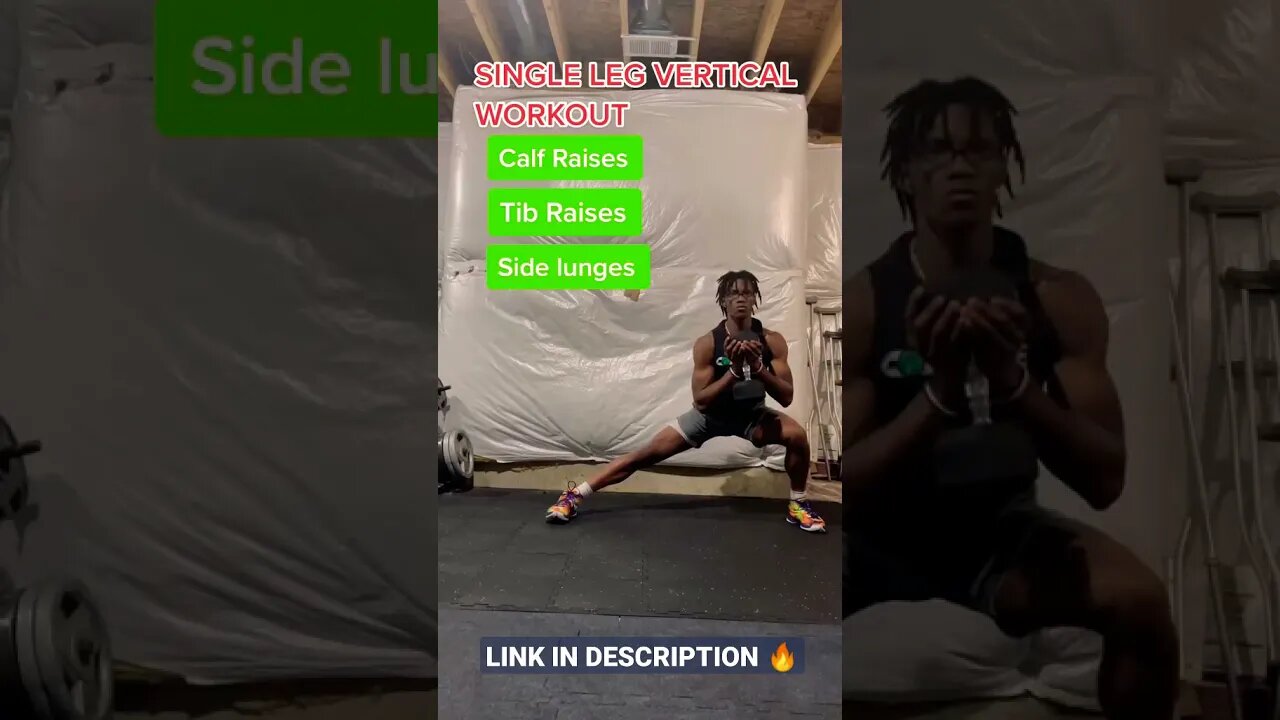Premium Only Content

SINGLE LEG VERTICAL WORKOUT 🦵🔥 #Shorts
THREE EXERCISES TO IMPROVE SINGLE LEG POWER
Explosive Two-Box Step-Up
In most sports, speed and acceleration are critical. How quick you get off the line, take your first step, or move to the ball is often the factor that separates the good athletes from the great ones. The challenge with most single-leg exercises is that they require a fairly high degree of balance, which means a lot of effort must be directed toward movement deceleration.
Here’s one way to progress a basic single-leg exercise—the Step-Up—to allow you to keep accelerating through the movement without having to stop to keep your balance.
These can be performed with dumbbells held at your side—for more posterior chain activation—or with a barbell or safety squat bar on your shoulders—for more quadriceps involvement.
Seated Single-Leg Bench Jump to a Box
If you’re looking at completeness of you training program, learning to quickly activate all available force from a dead stop is an important and novel training stimulus. This ability is typically measured by something called RFP, or Rate of Force Production—the human performance equivalent of a car’s 0-60mph time.
This exercise defuses the Stretch-Shortening Reflex (SSC) that is normally activated during the transition between the lengthening and shortening phase of an exercise. (Think the elastic rebound you get at the bottom of squat that helps push you back upright).
Avoid bouncing, wiggling, or using a big countermovement in your upper body when seated on the bench.
Start by jumping onto an 18-inch block. Progressively increase the height of the box in proportion to ability.
Single-Leg Deadlift with Medicine Ball Slam
Eccentric training—where a muscle actively lengthens under tension—is one of the most effective ways to increase overall strength and power output. Yet most people underutilize or ignore the eccentric component of most exercises.
This is a mistake for two reasons.
First, power is the product of force x velocity. Velocity is a function of speed and force is a function of strength. With this equation, we know that we can improve running and sprinting speed by increasing the amount of leg strength available per stride.
Second, the ability to control joint position and avoid soft-tissue injuries during high-speed movement is largely a function of eccentric control.
Here, we use a Medicine Ball, thrown downward from an overhead position, to create a rapid lengthening contraction that follows the form of single leg deadlift. The over-speed of the ball forces the hamstring and glute to decelerate the upper body as it moves toward the ground.
Explosive Two-Box Step-Up
In most sports, speed and acceleration are critical. How quick you get off the line, take your first step, or move to the ball is often the factor that separates the good athletes from the great ones. The challenge with most single-leg exercises is that they require a fairly high degree of balance, which means a lot of effort must be directed toward movement deceleration.
Here’s one way to progress a basic single-leg exercise—the Step-Up—to allow you to keep accelerating through the movement without having to stop to keep your balance.
These can be performed with dumbbells held at your side—for more posterior chain activation—or with a barbell or safety squat bar on your shoulders—for more quadriceps involvement.
Seated Single-Leg Bench Jump to a Box
If you’re looking at completeness of you training program, learning to quickly activate all available force from a dead stop is an important and novel training stimulus. This ability is typically measured by something called RFP, or Rate of Force Production—the human performance equivalent of a car’s 0-60mph time.
This exercise defuses the Stretch-Shortening Reflex (SSC) that is normally activated during the transition between the lengthening and shortening phase of an exercise. (Think the elastic rebound you get at the bottom of squat that helps push you back upright).
Avoid bouncing, wiggling, or using a big countermovement in your upper body when seated on the bench.
Start by jumping onto an 18-inch block. Progressively increase the height of the box in proportion to ability.
Single-Leg Deadlift with Medicine Ball Slam
Eccentric training—where a muscle actively lengthens under tension—is one of the most effective ways to increase overall strength and power output. Yet most people underutilize or ignore the eccentric component of most exercises.
This is a mistake for two reasons.
First, power is the product of force x velocity. Velocity is a function of speed and force is a function of strength. With this equation, we know that we can improve running and sprinting speed by increasing the amount of leg strength available per stride.
Second, the ability to control joint position and avoid soft-tissue injuries during high-speed movement is largely a function of eccentric control. .
. .
Link do Video: https://youtu.be/fBAMTzRvBI8
-
 30:53
30:53
Uncommon Sense In Current Times
1 day ago $6.01 earned"Pardon or Peril? How Biden’s Clemency Actions Could Backfire"
42.6K2 -
 40:01
40:01
CarlCrusher
19 hours agoSkinwalker Encounters in the Haunted Canyons of Magic Mesa - ep 4
40.9K2 -
 59:44
59:44
PMG
1 day ago $4.29 earned"BETRAYAL - Johnson's New Spending Bill EXPANDS COVID Plandemic Powers"
50.2K15 -
 6:48:50
6:48:50
Akademiks
17 hours agoKendrick Lamar and SZA disses Drake and BIG AK? HOLD UP! Diddy, Durk, JayZ update. Travis Hunter RUN
172K28 -
 11:45:14
11:45:14
Right Side Broadcasting Network
9 days agoLIVE REPLAY: TPUSA's America Fest Conference: Day Three - 12/21/24
355K28 -
 12:19
12:19
Tundra Tactical
17 hours ago $13.10 earnedDaniel Penny Beats Charges in NYC Subway Killing
72.1K13 -
 29:53
29:53
MYLUNCHBREAK CHANNEL PAGE
1 day agoUnder The Necropolis - Pt 1
161K52 -
 2:00:10
2:00:10
Bare Knuckle Fighting Championship
3 days agoCountdown to BKFC on DAZN HOLLYWOOD & FREE LIVE FIGHTS!
61.8K3 -
 2:53:01
2:53:01
Jewels Jones Live ®
1 day agoA MAGA-NIFICENT YEAR | A Political Rendezvous - Ep. 103
155K39 -
 29:54
29:54
Michael Franzese
21 hours agoCan Trump accomplish everything he promised? Piers Morgan Article Breakdown
139K83